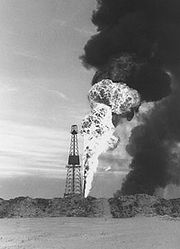
Leduc Formation
Encyclopedia
Leduc Formation is a stratigraphical
unit of Frasnian
age
in the Western Canadian Sedimentary Basin
.
It takes the name from the city of Leduc
, and was first described in B.A. Pyrz No. 1 well in central Alberta
(between 1,623.7 and 1,807.5m) by Imperial Oil Limited in 1950. A complete section was cored
in Imperial Oil's Leduc No. 530 well from 1633 metres (5,357.6 ft) to 1863 metres (6,112.2 ft).
consists of Stromatoporoid reefs with skeletal mudstone
and floatstone to finer grained muddy packstone and wackestone
. Dolomitisation is a common diagenesis
throughout the formation.
 Oil
Oil
and gas
is produced from the Leduc Formation in central Alberta
. The Leduc No. 1
well produced 50 million cubic metres (more than 300 million barrels) of oil and marked the beginning of the post-war Albertan oil boom.
buildups in a line following the Woodbend shelf margin from Drumheller
in central Alberta
to Peace River
Arch area in northern Alberta
. The formation is absent in inter-reef areas, and build-ups reach from 180 metres (590.6 ft) to 300 metres (984.3 ft).
s in central Alberta. In northern Alberta
, it rests directly on precambrian
red beds or on Granite Wash. The Leduc reefs are surrounded by younger sediments, such as the Duvernay and Ireton Formations carbonates or Woodbend Group
shale.
Stratigraphy
Stratigraphy, a branch of geology, studies rock layers and layering . It is primarily used in the study of sedimentary and layered volcanic rocks....
unit of Frasnian
Frasnian
The Frasnian is one of two faunal stages in the Late Devonian epoch. It lasted from 385.3 ± 2.6 million years ago to 374.5 ± 2.6 million years ago. It was preceded by the Givetian stage and followed by the Famennian stage...
age
Geochronology
Geochronology is the science of determining the age of rocks, fossils, and sediments, within a certain degree of uncertainty inherent to the method used. A variety of dating methods are used by geologists to achieve this, and schemes of classification and terminology have been proposed...
in the Western Canadian Sedimentary Basin
Western Canadian Sedimentary Basin
The Western Canadian Sedimentary Basin is a vast sedimentary basin underlying of Western Canada including southwestern Manitoba, southern Saskatchewan, Alberta, northeastern British Columbia and the southwest corner of the Northwest Territories. It consists of a massive wedge of sedimentary rock...
.
It takes the name from the city of Leduc
Leduc, Alberta
- Demographics :The population of the City of Leduc according to its 2011 municipal census is 24,139, a 3.6% increase over its 2010 municipal census population of 23,293....
, and was first described in B.A. Pyrz No. 1 well in central Alberta
Central Alberta
Central Alberta is a region located in the Canadian province of Alberta.Central Alberta is the most densely populated rural area in the province...
(between 1,623.7 and 1,807.5m) by Imperial Oil Limited in 1950. A complete section was cored
Coring
Coring happens when a heated alloy, such as a Cu-Ni system, cools in non-equilibrium conditions. This causes the exterior of the material to harden faster than the interior. Coring causes the exterior layers to retain more of the higher melting temperature element...
in Imperial Oil's Leduc No. 530 well from 1633 metres (5,357.6 ft) to 1863 metres (6,112.2 ft).
Lithology
The Leduc Formation was deposited in a shallow water reef environment, and the limestoneLimestone
Limestone is a sedimentary rock composed largely of the minerals calcite and aragonite, which are different crystal forms of calcium carbonate . Many limestones are composed from skeletal fragments of marine organisms such as coral or foraminifera....
consists of Stromatoporoid reefs with skeletal mudstone
Mudstone
Mudstone is a fine grained sedimentary rock whose original constituents were clays or muds. Grain size is up to 0.0625 mm with individual grains too small to be distinguished without a microscope. With increased pressure over time the platey clay minerals may become aligned, with the...
and floatstone to finer grained muddy packstone and wackestone
Wackestone
Wackestone is a matrix-supported carbonate rock that contains over 10% allochems in a carbonate mud matrix. This is part of the Dunham classification of carbonate rocks. In the other widely used classification due to Folk, an equivalent description would be, for example, an oopelmicrite, where the...
. Dolomitisation is a common diagenesis
Diagenesis
In geology and oceanography, diagenesis is any chemical, physical, or biological change undergone by a sediment after its initial deposition and during and after its lithification, exclusive of surface alteration and metamorphism. These changes happen at relatively low temperatures and pressures...
throughout the formation.
Oil and gas production

Petroleum
Petroleum or crude oil is a naturally occurring, flammable liquid consisting of a complex mixture of hydrocarbons of various molecular weights and other liquid organic compounds, that are found in geologic formations beneath the Earth's surface. Petroleum is recovered mostly through oil drilling...
and gas
Natural gas
Natural gas is a naturally occurring gas mixture consisting primarily of methane, typically with 0–20% higher hydrocarbons . It is found associated with other hydrocarbon fuel, in coal beds, as methane clathrates, and is an important fuel source and a major feedstock for fertilizers.Most natural...
is produced from the Leduc Formation in central Alberta
Central Alberta
Central Alberta is a region located in the Canadian province of Alberta.Central Alberta is the most densely populated rural area in the province...
. The Leduc No. 1
Leduc No. 1
Leduc No. 1 was a major crude oil discovery made near Leduc, Alberta, Canada on February 13, 1947. It provided the geological key to Alberta's most prolific conventional oil reserves and resulted in a boom in petroleum exploration and development across Western Canada...
well produced 50 million cubic metres (more than 300 million barrels) of oil and marked the beginning of the post-war Albertan oil boom.
Distribution
Leduc Formation occurs as discrete reefReef
In nautical terminology, a reef is a rock, sandbar, or other feature lying beneath the surface of the water ....
buildups in a line following the Woodbend shelf margin from Drumheller
Drumheller, Alberta
Drumheller is a town within the Red Deer River valley in the badlands of east-central Alberta, Canada. It is located northeast of Calgary...
in central Alberta
Central Alberta
Central Alberta is a region located in the Canadian province of Alberta.Central Alberta is the most densely populated rural area in the province...
to Peace River
Peace River, Alberta
Peace River is a town in northwestern Alberta, Canada, situated along the banks of the Peace River, at its confluence with the Smoky River, the Heart River and Pat's Creek. It is located northwest of Edmonton, and northeast of Grande Prairie, along Highway 2. The Peace River townsite is nearly ...
Arch area in northern Alberta
Northern Alberta
Northern Alberta is a region located in the Canadian province of Alberta.Its primary industry is oil and gas, with large heavy oil reserves being exploited at the Athabasca Oil Sands and Wabasca Area in the east of the region...
. The formation is absent in inter-reef areas, and build-ups reach from 180 metres (590.6 ft) to 300 metres (984.3 ft).
Relationship to other units
Leduc Formation conformably overlays the Cooking Lake Formation and the Beaverhill Lake Formation platform carbonateCarbonate
In chemistry, a carbonate is a salt of carbonic acid, characterized by the presence of the carbonate ion, . The name may also mean an ester of carbonic acid, an organic compound containing the carbonate group C2....
s in central Alberta. In northern Alberta
Northern Alberta
Northern Alberta is a region located in the Canadian province of Alberta.Its primary industry is oil and gas, with large heavy oil reserves being exploited at the Athabasca Oil Sands and Wabasca Area in the east of the region...
, it rests directly on precambrian
Precambrian
The Precambrian is the name which describes the large span of time in Earth's history before the current Phanerozoic Eon, and is a Supereon divided into several eons of the geologic time scale...
red beds or on Granite Wash. The Leduc reefs are surrounded by younger sediments, such as the Duvernay and Ireton Formations carbonates or Woodbend Group
Woodbend Group
The Woodbend Group is a stratigraphical unit of Frasnian age in the Western Canadian Sedimentary Basin.It was first described in the British American Pyrcz No...
shale.

